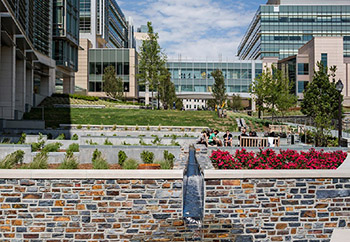Duke’s School of Medicine Building Achieves LEED Gold
 DURHAM, N.C. — Duke University’s School of Medicine recently announced that the new Mary Duke Biddle Trent Semans Center is the first building to achieve LEED Gold certification on the medical center campus in Durham.
DURHAM, N.C. — Duke University’s School of Medicine recently announced that the new Mary Duke Biddle Trent Semans Center is the first building to achieve LEED Gold certification on the medical center campus in Durham.
The 115,000-square-foot building was designed by S/L/A/M Collaborative (SLAM), headquartered in Glastonbury, Conn., in collaboration with Duda Paine Architects of Durham, N.C. It was initially planned to achieve LEED Silver, but, the $53 million building was granted 98 percent of the total attempted points for LEED Gold certification.
The six-story center is the first new medical building on the campus in 80 years. It is a modern, state-of-the-art medical education facility that mimics the 924-bed Duke University Medical Center.
“We created simulation labs and clinical skill labs directly set up and oriented exactly the way the patient rooms are in the hospital next door,” said Ray Weaver, project manager with SLAM. “What the students are learning in is the exact same environment they will be performing in.”
The building was designed to incorporate a sense of continuity using sightlines and materiality. As such, a pedestrian pathway surrounds the building to enhance the outdoor environment. The building hosts several outdoor study areas and the fourth floor contains an outdoor student lounge. More than half of the site was restored with adaptive plants and grasses that are native to the region.
The site’s terraced rain garden captures all of the stormwater runoff from the adjoining roofs and surface run-off, serving as both water retention and water filtering steps before being recaptured into the campus stormwater system. The rain garden is both functional and a beautiful addition to the building, said Greg Bergmiller, LEED AP, sustainable design coordinator with SLAM.
“It’s an example of utilizing the stormwater design for not only dealing with stormwater but also a very beautiful and articulated space that people can use and coexist with it,” Bergmiller said.
To further stress the connection to the outdoors, the glass-filled southern façade is situated as the front base of the medical campus, providing ample views and daylight. The southern façade incorporates horizontal light shelves while the western façade uses vertical fins, which reduces overheating and saves energy through reduced lighting loads. The amount of glass used in the long southern façade also creates a kind of activity zone, Weaver said.
“At night the building becomes sort of a glowing beacon of activity,” Weaver said. “You’re able to visually connect from the outside into the building.”
One simple but impactful design decision to achieve LEED points was the use of a white roofing membrane, Bergmiller said. Using the cool roofing membrane is especially important in warmer climates.
“If you have a black roofing membrane up there, it can actually be 50 degrees hotter than what the ambient temperature of the day is,” Bergmiller said. “By putting that cool roof membrane up there, you’re reducing that demand by an extra 40 to 50 degrees right away so that it’s pulling more air from the ambient temperature.”
The building also monitors air flow to enhance the learning environment. The mechanical system can sense occupancy and monitor CO2 levels, which controls air flow with variable speed drives and reduces energy consumption and improves indoor air quality.
The Mary Duke Biddle Trent Semans Center began welcoming students in February 2013.
